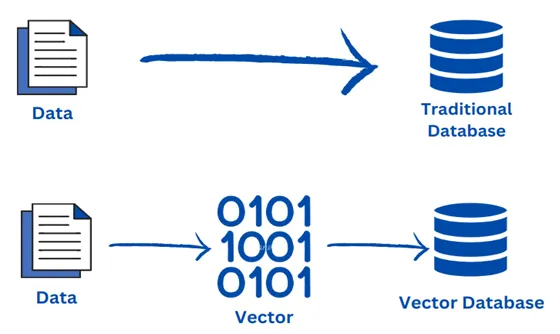
Vector Database for AI
WHAT PROBLEMS DOES IT FIX?
Inefficient Data Storage: Without a vector database, businesses may struggle to store and manage large amounts of high-dimensional data effectively.
Lack of Scalability: Vector databases are designed to handle large volumes of data, without one, businesses may struggle to scale their AI applications.
Poor Query Performance: Without a vector database, query performance may be slow, leading to frustrated users and lost productivity.
Inaccurate Results: Without a vector database, AI models may produce inaccurate results, leading to poor decision-making and reputational damage.
Increased Development Time: Building a vector database from scratch can take months, delaying AI application development and deployment.
Higher Development Costs: Building a vector database infrastructure can be costly, putting a strain on business resources.
Limited AI Capabilities: Without a vector database, businesses may be limited in the AI applications they can develop and deploy.
Difficulty in Data Retrieval: Without a vector database, retrieving specific data points can be time-consuming and tedious.
Inability to Handle High-Dimensional Data: Vector databases are designed to handle high-dimensional data, without one, businesses may struggle to work with complex data sets.
Inefficient Use of Computational Resources: Without a vector database, computational resources may be wasted on inefficient data processing and querying.
Data Inconsistencies: Without a vector database, data inconsistencies can lead to inaccurate results and poor decision-making.
Lack of Data Normalization: Without a vector database, data may not be properly normalized, leading to data inconsistencies and inaccuracies.
Difficulty in Data Visualization: Without a vector database, visualizing high-dimensional data can be challenging, making it difficult to understand and analyze.
Security Risks: Without a vector database, sensitive data may be at risk of being compromised.
Compliance Issues: Without a vector database, businesses may struggle to comply with regulations and standards for data management.
Limited Data Analytics: Without a vector database, businesses may be limited in their ability to analyze and gain insights from their data.
Inability to Handle Real-Time Data: Without a vector database, businesses may struggle to handle real-time data streams.
Difficulty in Data Integration: Without a vector database, integrating data from multiple sources can be challenging.
Lack of Data Validation: Without a vector database, data may not be properly validated, leading to inaccurate results and poor decision-making.
Inability to Handle Sparse Data: Without a vector database, businesses may struggle to handle sparse data, leading to inefficient data storage and querying.
Difficulty in Data Cleaning: Without a vector database, cleaning and preprocessing data can be time-consuming and tedious.
Lack of Data Backup and Recovery: Without a vector database, businesses may struggle to backup and recover their data in the event of a disaster.
Inability to Handle High-Dimensional Indexing: Without a vector database, businesses may struggle to index and query high-dimensional data.
Difficulty in Data Partitioning: Without a vector database, partitioning data can be challenging, leading to inefficient data querying and analysis.
Lack of Support for Advanced Data Types: Without a vector database, businesses may struggle to support advanced data types, such as vectors and matrices.
Inability to Handle Distributed Data: Without a vector database, businesses may struggle to handle distributed data, leading to inefficient data querying and analysis.
Difficulty in Data Replication: Without a vector database, replicating data can be challenging, leading to data inconsistencies and inaccuracies.
Lack of Support for Real-Time Analytics: Without a vector database, businesses may struggle to support real-time analytics and decision-making.
Inability to Handle Streaming Data: Without a vector database, businesses may struggle to handle streaming data, leading to inefficient data querying and analysis.
Difficulty in Data Quality Control: Without a vector database, controlling data quality can be challenging, leading to inaccurate results and poor decision-making.
Lack of Data Governance: Without a vector database, governing data can be challenging, leading to data inconsistencies and inaccuracies.
Inability to Support Data Science Workflows: Without a vector database, supporting data science workflows can be challenging, leading to inefficient data analysis and decision-making.
Difficulty in Data Collaboration: Without a vector database, collaborating on data can be challenging, leading to data inconsistencies and inaccuracies.
Lack of Support for Explainability: Without a vector database, explaining AI model decisions can be challenging, leading to a lack of trust in AI applications.
Inability to Support Transparency: Without a vector database, ensuring transparency in AI decision-making can be challenging, leading to a lack of trust in AI applications.
Difficulty in Supporting Fairness and Bias Detection: Without a vector database, detecting and mitigating bias in AI applications can be challenging, leading to unfair outcomes.
Lack of Support for Model Interpretability: Without a vector database, interpreting AI model decisions can be challenging, leading to a lack of trust in AI applications.
Inability to Support Model Explainability: Without a vector database, explaining AI model decisions can be challenging, leading to a lack of trust in AI applications.
Difficulty in Support for Model Debugging: Without a vector database, debugging AI models can be challenging, leading to inefficient model development and deployment.
Lack of Support for Model Refining: Without a vector database, refining AI models can be challenging, leading to inefficient model development and deployment.
Inability to Support Model Versioning: Without a vector database, versioning AI models can be challenging, leading to inefficient model development and deployment.
Difficulty in Support for Model Serving: Without a vector database, serving AI models can be challenging, leading to inefficient model deployment and management.
Lack of Support for Model Monitoring: Without a vector database, monitoring AI models can be challenging, leading to inefficient model deployment and management.
Inability to Support Data-Driven Decision Making: Without a vector database, making data-driven decisions can be challenging, leading to poor business outcomes.
Difficulty in Supporting Real-Time Decision Making: Without a vector database, making real-time decisions can be challenging, leading to poor business outcomes.
Vector Database for AI
$10000 - 30000 per installation
AI applicatons relies on vector databases. Building a vector database infrastructure is very hard and costly. ABN offers ready-built vector database infrastructure you just have to use.
WHAT PROBLEMS DOES IT FIX?
Inefficient Data Storage: Without a vector database, businesses may struggle to store and manage large amounts of high-dimensional data effectively.
Lack of Scalability: Vector databases are designed to handle large volumes of data, without one, businesses may struggle to scale their AI applications.
Poor Query Performance: Without a vector database, query performance may be slow, leading to frustrated users and lost productivity.
Inaccurate Results: Without a vector database, AI models may produce inaccurate results, leading to poor decision-making and reputational damage.
Increased Development Time: Building a vector database from scratch can take months, delaying AI application development and deployment.
Higher Development Costs: Building a vector database infrastructure can be costly, putting a strain on business resources.
Limited AI Capabilities: Without a vector database, businesses may be limited in the AI applications they can develop and deploy.
Difficulty in Data Retrieval: Without a vector database, retrieving specific data points can be time-consuming and tedious.
Inability to Handle High-Dimensional Data: Vector databases are designed to handle high-dimensional data, without one, businesses may struggle to work with complex data sets.
Inefficient Use of Computational Resources: Without a vector database, computational resources may be wasted on inefficient data processing and querying.
Data Inconsistencies: Without a vector database, data inconsistencies can lead to inaccurate results and poor decision-making.
Lack of Data Normalization: Without a vector database, data may not be properly normalized, leading to data inconsistencies and inaccuracies.
Difficulty in Data Visualization: Without a vector database, visualizing high-dimensional data can be challenging, making it difficult to understand and analyze.
Security Risks: Without a vector database, sensitive data may be at risk of being compromised.
Compliance Issues: Without a vector database, businesses may struggle to comply with regulations and standards for data management.
Limited Data Analytics: Without a vector database, businesses may be limited in their ability to analyze and gain insights from their data.
Inability to Handle Real-Time Data: Without a vector database, businesses may struggle to handle real-time data streams.
Difficulty in Data Integration: Without a vector database, integrating data from multiple sources can be challenging.
Lack of Data Validation: Without a vector database, data may not be properly validated, leading to inaccurate results and poor decision-making.
Inability to Handle Sparse Data: Without a vector database, businesses may struggle to handle sparse data, leading to inefficient data storage and querying.
Difficulty in Data Cleaning: Without a vector database, cleaning and preprocessing data can be time-consuming and tedious.
Lack of Data Backup and Recovery: Without a vector database, businesses may struggle to backup and recover their data in the event of a disaster.
Inability to Handle High-Dimensional Indexing: Without a vector database, businesses may struggle to index and query high-dimensional data.
Difficulty in Data Partitioning: Without a vector database, partitioning data can be challenging, leading to inefficient data querying and analysis.
Lack of Support for Advanced Data Types: Without a vector database, businesses may struggle to support advanced data types, such as vectors and matrices.
Inability to Handle Distributed Data: Without a vector database, businesses may struggle to handle distributed data, leading to inefficient data querying and analysis.
Difficulty in Data Replication: Without a vector database, replicating data can be challenging, leading to data inconsistencies and inaccuracies.
Lack of Support for Real-Time Analytics: Without a vector database, businesses may struggle to support real-time analytics and decision-making.
Inability to Handle Streaming Data: Without a vector database, businesses may struggle to handle streaming data, leading to inefficient data querying and analysis.
Difficulty in Data Quality Control: Without a vector database, controlling data quality can be challenging, leading to inaccurate results and poor decision-making.
Lack of Data Governance: Without a vector database, governing data can be challenging, leading to data inconsistencies and inaccuracies.
Inability to Support Data Science Workflows: Without a vector database, supporting data science workflows can be challenging, leading to inefficient data analysis and decision-making.
Difficulty in Data Collaboration: Without a vector database, collaborating on data can be challenging, leading to data inconsistencies and inaccuracies.
Lack of Support for Explainability: Without a vector database, explaining AI model decisions can be challenging, leading to a lack of trust in AI applications.
Inability to Support Transparency: Without a vector database, ensuring transparency in AI decision-making can be challenging, leading to a lack of trust in AI applications.
Difficulty in Supporting Fairness and Bias Detection: Without a vector database, detecting and mitigating bias in AI applications can be challenging, leading to unfair outcomes.
Lack of Support for Model Interpretability: Without a vector database, interpreting AI model decisions can be challenging, leading to a lack of trust in AI applications.
Inability to Support Model Explainability: Without a vector database, explaining AI model decisions can be challenging, leading to a lack of trust in AI applications.
Difficulty in Support for Model Debugging: Without a vector database, debugging AI models can be challenging, leading to inefficient model development and deployment.
Lack of Support for Model Refining: Without a vector database, refining AI models can be challenging, leading to inefficient model development and deployment.
Inability to Support Model Versioning: Without a vector database, versioning AI models can be challenging, leading to inefficient model development and deployment.
Difficulty in Support for Model Serving: Without a vector database, serving AI models can be challenging, leading to inefficient model deployment and management.
Lack of Support for Model Monitoring: Without a vector database, monitoring AI models can be challenging, leading to inefficient model deployment and management.
Inability to Support Data-Driven Decision Making: Without a vector database, making data-driven decisions can be challenging, leading to poor business outcomes.
Difficulty in Supporting Real-Time Decision Making: Without a vector database, making real-time decisions can be challenging, leading to poor business outcomes.
KEY BENEFITS
Faster Development: Get started with your AI application quickly without worrying about building a vector database infrastructure from scratch
Reduced Costs: Save money by avoiding the high costs of building and maintaining a vector database infrastructure in-house
Increased Scalability: Handle large amounts of data and scale up or down as needed with a ready-built vector database infrastructure
Improved Performance: Enjoy faster query performance and response times with a highly optimized vector database infrastructure
Enhanced Data Management: Efficiently manage and process large amounts of vector data with a robust vector database infrastructure
Better Collaboration: Enable seamless collaboration among data scientists, engineers, and researchers with a shared vector database infrastructure
Enhanced Security: Protect sensitive vector data with robust security features and access controls built into the vector database infrastructure
Reduced Complexity: Simplify your AI application development by offloading vector database infrastructure complexities to ABN
Faster Time-to-Market: Get your AI application to market faster by leveraging a pre-built vector database infrastructure
Improved Data Analysis: Gain deeper insights and make better decisions with a vector database infrastructure optimized for AI workloads
KEY FEATURES
Scalability: Horizontally scalable to handle large volumes of data and high-performance computing
Real-time Indexing: Supports real-time indexing for fast data ingestion and querying
High-Performance Computing: Optimized for high-performance computing to handle computationally intensive AI workloads
Distributed Architecture: Distributed architecture for fault tolerance and high availability
Vector Similarity Search: Supports fast and accurate vector similarity searches for AI applications
High-Dimensional Data Support: Designed to handle high-dimensional data for AI model training and inference
Low-Latency Querying: Optimized for low-latency querying for real-time AI applications
Data Versioning: Supports data versioning for tracking changes and rolling back to previous versions
Security and Access Control: Robust security and access control mechanisms to protect sensitive AI data
Integration with AI Frameworks: Seamless integration with popular AI frameworks and libraries
WHO USES THE PRODUCT
Computer Vision Engineers: Use vector databases to index and search high-dimensional image features for object detection and image retrieval applications.
Natural Language Processing Researchers: Employ vector databases to store and query dense embeddings for semantic search, text classification, and language modeling tasks.
Recommendation System Developers: Leverage vector databases to build real-time recommendation systems using collaborative filtering and content-based filtering techniques.
Autonomous Vehicle Engineers: Utilize vector databases to efficiently index and query large datasets of sensor and visual data for object detection and scene understanding.
Data Scientists: Use vector databases to perform fast similarity searches and clustering on high-dimensional data for anomaly detection and pattern recognition.
Speech Recognition Engineers: Apply vector databases to index and query acoustic features for speech recognition and speaker identification tasks.
Robotics and Control System Engineers: Employ vector databases to efficiently store and query large datasets of sensor and control data for robotic manipulation and control.
Cybersecurity Experts: Use vector databases to analyze and detect anomalies in high-dimensional network traffic data for intrusion detection and threat analysis.
Healthcare and Bioinformatics Researchers: Utilize vector databases to index and query high-dimensional genomic and biomedical data for similarity searches and clustering tasks.
Marketing and Advertising Analysts: Leverage vector databases to analyze customer behavior and preferences using high-dimensional data for personalized marketing and recommendations.











